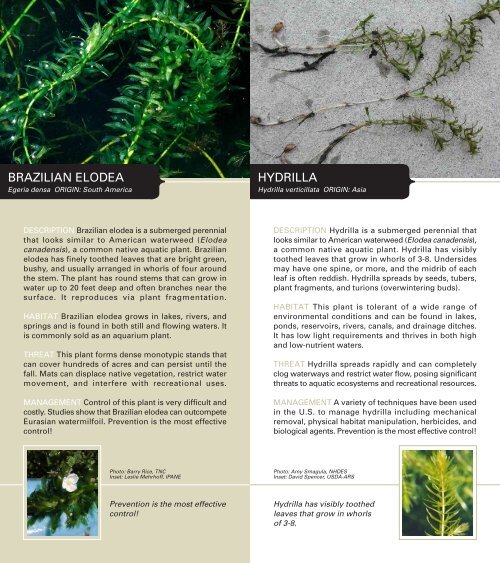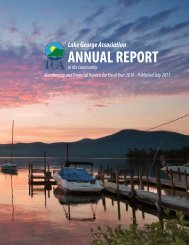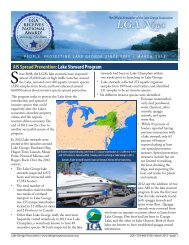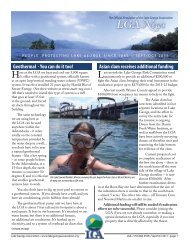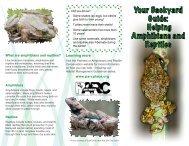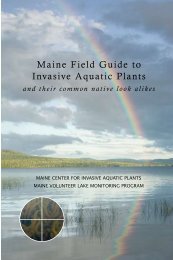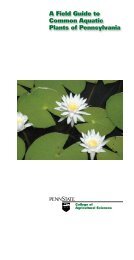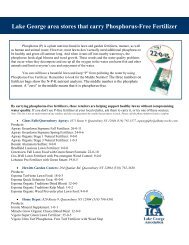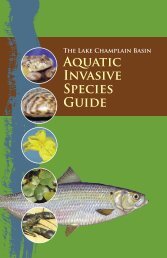Invasive Plants of the Adirondacks - Adirondack Park Invasive Plant ...
Invasive Plants of the Adirondacks - Adirondack Park Invasive Plant ...
Invasive Plants of the Adirondacks - Adirondack Park Invasive Plant ...
You also want an ePaper? Increase the reach of your titles
YUMPU automatically turns print PDFs into web optimized ePapers that Google loves.
BRAZILIAN ELODEA<br />
Egeria densa ORIGIN: South America<br />
HYDRILLA<br />
Hydrilla verticillata ORIGIN: Asia<br />
DESCRIPTION Brazilian elodea is a submerged perennial<br />
that looks similar to American waterweed (Elodea<br />
canadensis), a common native aquatic plant. Brazilian<br />
elodea has finely too<strong>the</strong>d leaves that are bright green,<br />
bushy, and usually arranged in whorls <strong>of</strong> four around<br />
<strong>the</strong> stem. The plant has round stems that can grow in<br />
water up to 20 feet deep and <strong>of</strong>ten branches near <strong>the</strong><br />
surface. It reproduces via plant fragmentation.<br />
HABITAT Brazilian elodea grows in lakes, rivers, and<br />
springs and is found in both still and flowing waters. It<br />
is commonly sold as an aquarium plant.<br />
THREAT This plant forms dense monotypic stands that<br />
can cover hundreds <strong>of</strong> acres and can persist until <strong>the</strong><br />
fall. Mats can displace native vegetation, restrict water<br />
movement, and interfere with recreational uses.<br />
MANAGEMENT Control <strong>of</strong> this plant is very difficult and<br />
costly. Studies show that Brazilian elodea can outcompete<br />
Eurasian watermilfoil. Prevention is <strong>the</strong> most effective<br />
control!<br />
DESCRIPTION Hydrilla is a submerged perennial that<br />
looks similar to American waterweed (Elodea canadensis),<br />
a common native aquatic plant. Hydrilla has visibly<br />
too<strong>the</strong>d leaves that grow in whorls <strong>of</strong> 3-8. Undersides<br />
may have one spine, or more, and <strong>the</strong> midrib <strong>of</strong> each<br />
leaf is <strong>of</strong>ten reddish. Hydrilla spreads by seeds, tubers,<br />
plant fragments, and turions (overwintering buds).<br />
HABITAT This plant is tolerant <strong>of</strong> a wide range <strong>of</strong><br />
environmental conditions and can be found in lakes,<br />
ponds, reservoirs, rivers, canals, and drainage ditches.<br />
It has low light requirements and thrives in both high<br />
and low-nutrient waters.<br />
THREAT Hydrilla spreads rapidly and can completely<br />
clog waterways and restrict water flow, posing significant<br />
threats to aquatic ecosystems and recreational resources.<br />
MANAGEMENT A variety <strong>of</strong> techniques have been used<br />
in <strong>the</strong> U.S. to manage hydrilla including mechanical<br />
removal, physical habitat manipulation, herbicides, and<br />
biological agents. Prevention is <strong>the</strong> most effective control!<br />
Photo: Barry Rice, TNC<br />
Inset: Leslie Mehrh<strong>of</strong>f, IPANE<br />
Photo: Amy Smagula, NHDES<br />
Inset: David Spencer, USDA-ARS<br />
Prevention is <strong>the</strong> most effective<br />
control!<br />
Hydrilla has visibly too<strong>the</strong>d<br />
leaves that grow in whorls<br />
<strong>of</strong> 3-8.


